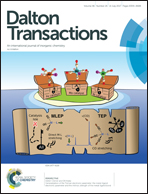Highly efficient visible-light-driven photocatalytic degradation of tetracycline by a Z-scheme g-C3N4/Bi3TaO7 nanocomposite photocatalyst†
Abstract
Spatial separation of photogenerated electron-hole pairs is one of the most important factors that determine the efficiency of a photocatalyst. It is well acknowledged that the fabrication of heterogeneous photocatalysts with two different inorganic semiconductors is a good strategy to effectively improve the charge separation of electrons and holes. This study describes a novel visible light-induced g-C3N4/Bi3TaO7 composite photocatalyst with superior photocatalytic properties toward the degradation of tetracycline (TC) by visible light irradiation. The formation of heterojunctions significantly improves the separation efficiency of photogenerated carriers, which is confirmed by the photocurrent density and electrochemical impedance spectroscopy. Electron spin resonance examination and trapping experiments confirm that the photoinduced active species (˙OH and ˙O2−) are responsible for the degradation of tetracycline. Based on the experimental results, a possible Z-scheme system reaction mechanism for the g-C3N4/Bi3TaO7 composite towards the degradation of TC under visible light was proposed.



 Please wait while we load your content...
Please wait while we load your content...